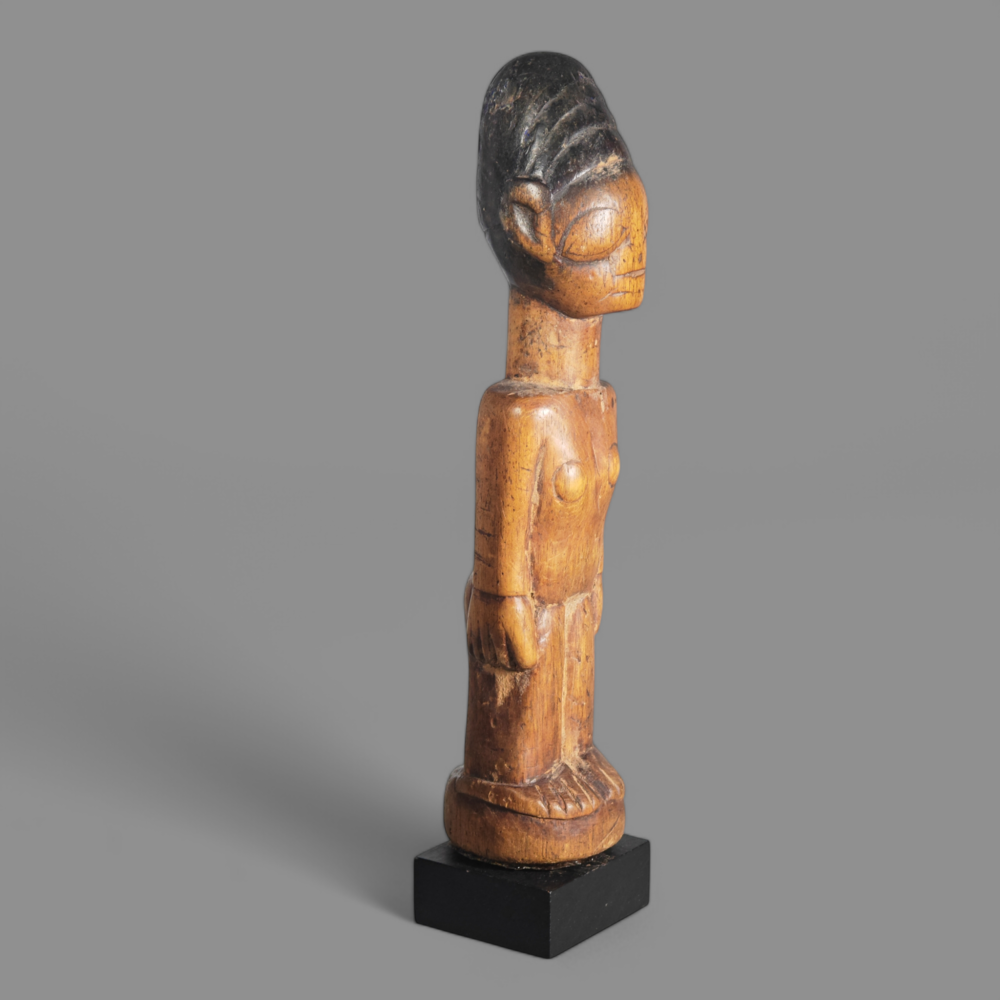
Ibeji Anago
Anago - 27cm
Les Anago, également désignés sous les appellations Nago ou Ana au Togo, constituent une branche du vaste ensemble yoruba, issue des migrations depuis leur foyer historique d’Ile-Ife, cité mythique considérée comme le berceau originel du peuple yoruba. Dès le XVIIᵉ siècle, ces populations s’établirent sur les terres de l’actuel Dahomey, où elles conservèrent un socle cultuel et spirituel en parfaite continuité avec celui de leurs cousins restés au Nigeria. Parmi ces traditions, le culte des jumeaux occupe une place centrale, témoignant de la persistance des croyances ancestrales et de leur importance dans l’organisation sociale et religieuse des Anago.
Toutefois, les Ibeji façonnés par les Anago se révèlent d’une rareté exceptionnelle, leur production ayant été bien plus limitée que celle des centres yoruba du Nigeria. Les bois employés proviennent des essences locales du Bénin, souvent d’une teinte plus claire, rappelant les statuettes Hohovi réalisées par les peuples Adja et Fon de la région. Malgré ces spécificités matérielles, l’esthétique des Ibeji Anago demeure profondément ancrée dans les codes stylistiques yoruba, traduisant ainsi une fidélité aux canons sculpturaux du Nigeria tout en intégrant des nuances propres à leur territoire d’adoption.
L’Ibeji que nous présentons ici illustre à la perfection cette synthèse stylistique. On y retrouve l’iconographie caractéristique des productions yoruba : la stylisation distinctive du regard, la posture hiératique, les proportions harmonieuses, ainsi que le traitement sophistiqué de la coiffe, marqué par l’application de multiples couches de pigments indigo et l’incrustation de Reckitt’s Blue, éléments indissociables des sculptures dédiées au culte des jumeaux.
Des photographies haute définition, un rapport détaillé de provenance ainsi que le prix de cette œuvre pourront être communiqués sur simple requête.
The Anago, also referred to as Nago or Ana in Togo, represent a branch of the vast Yoruba cultural sphere, originating from migrations out of their historical homeland in Ile-Ife, the mythical city regarded as the ancestral cradle of the Yoruba people. As early as the 17th century, these groups settled in the territory of present-day Dahomey, where they preserved a religious and spiritual foundation that remained closely aligned with that of their kin in Nigeria. Among these enduring traditions, the cult of twins holds a preeminent place, underscoring the Anago people's commitment to ancestral beliefs and their role in the social and religious structure.
However, Ibeji figures produced by the Anago are of notable rarity, as their production was considerably more limited compared to the major Yoruba sculptural centers of Nigeria. The wood used in their creation comes from Beninese tree species, typically of a lighter hue, reminiscent of the Hohovi statuettes crafted by the Adja and Fon peoples of the region. Despite these material distinctions, the aesthetic of Anago Ibeji remains deeply rooted in the sculptural traditions of the Yoruba, maintaining stylistic fidelity to Nigerian prototypes while incorporating subtle regional variations.
The Ibeji presented here exemplifies this synthesis with remarkable clarity. It exhibits the hallmark characteristics of Yoruba production: the distinctive stylization of the eyes, the hieratic posture, the balanced proportions, and, most notably, the elaborate treatment of the coiffure, featuring multiple layers of indigo pigment and the incrustation of Reckitt’s Blue, essential attributes of sculptures dedicated to the twin cult.
High-definition photographs, a detailed provenance report, and pricing information are available upon request.
Anago, tí a tún mọ̀ sí Nago tàbí Ana ní Togo, jẹ́ ẹ̀ka kan nínú ìdílé àṣà Yoruba, tí ó bẹ̀rẹ̀ látinú ìkọ̀kọ̀ wọn ní Ile-Ife, ìlú tó jẹ́ ilé ìbílẹ̀ àti àkọ́kọ́ àwọn Yoruba. Láti orundún kẹrìndínlógún (17th century), àwọn yìí ti fi àgbègbè Dahomey sílẹ̀, níbi tí wọ́n ti tọju àṣà ìsìn àti ẹ̀sìn wọn pẹ̀lú ìbáṣepọ̀ pẹ̀lú àwọn ìdílé wọn tí ó ku ní Nigeria. Lára àwọn ìṣe pàtàkì tí wọ́n kó pọ̀, ìsìn àwọn jùmọ̀ jẹ́ ohun pàtàkì jùlọ, tó fi hàn pé àwọn Anago ti ní àṣà ìsìn àtijọ́ àti ipa rẹ̀ nínú àjọṣe àti ìjọba ìsìn wọn.
Síbẹ̀, Ìbejì tí àwọn Anago dá jẹ́ rárá pátápátá, nítorí pé a ti ṣe wọn ní ìwọ̀n tó kéré jùlọ ní kákàkí àwọn ile iṣẹ́ Yoruba tó wà ní Nigeria. Igí tí wọ́n lò jẹ́ ti àwọn igi Bénin, tí ó ní àwọ̀ tó mọ́ jùlọ, tí ó fi hàn bíi Hohovi àwọn Adja àti Fon tí wọ́n ṣe nínú agbègbè yẹn. Bí ó tilẹ̀ jẹ́ pé àwọn ohun elo wọ̀nyí ni wọ́n lo, àṣà iṣẹ́ Ìbejì Anago wà pẹ̀lú àwọn àṣà Yoruba, tí ó nímúra rẹ̀ sí ìmọ̀ràn àwọn àṣà Nigeria, nípa ṣiṣepọ̀ àwọn irò àtọkànwá pẹ̀lú àwọn ẹ̀ka wọn.
Ìbejì tí a fi hàn yìí jẹ́ àpẹẹrẹ gidi ti ìkànsí àwòkọ̀sílẹ̀ yìí. A rí àwọn àfiṣàànú pataki ti iṣẹ́ Yoruba: ìmúlò ojú tó ṣe kedere, ipò ìwàláàyè tó péye, ìpinnu tó bójú mu, àti pẹ̀lú rẹ̀, ìtọ́jú ìrun tí ó ni àwọn àkọsílẹ̀ ẹ̀dá indigo àti incrustation Reckitt’s Blue, ohun tó jẹ́ àfihàn ti a fi ń tọ́ka sí ìsìn àwọn jùmọ̀.
Àwọn àwòrán gíga HD, ìtàn ìbùdó rẹ̀ ní ìṣàlè, àti ìlò owó le fi ránṣẹ́ sí ọ lórí ìbéèrè kan ṣoṣo.
